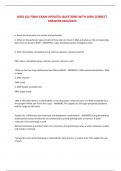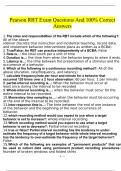BIOD 101 FINAL EXAM UPD ATED QUESTIONS WITH 100% CORRECT ANSWERS 2024/2025 a. Name the three parts of a nucleic acid nucleotide. b. What are the particular types of each of these that are found in DNA and what are the corresponding types that are found in RNA? - ANSWERS a. sugar, phosphate group, nitrogenous base b. DNA - deoxyribose - phosphate group - adenine, guanine, cytosine, thymine RNA - ribose -phosphate group - adenine, guanine, cytosine, uracil What are the four major differences btw DNA and RNA? - ANSWERS 1. DNA contains deoxyribose - RNA is ribose 2. DNA: thymine RNA: uracil 3. DNA: double stranded helix RNA: single strand DNA is often described as a coiled ladder. In this description, what two parts of a DNA nucleotide form the uprights? What part forms the rungs? - ANSWERS The uprights are the sugar phosphate backbone, and the rungs are the bases. Explain the 2 differences btw hydrolysis and dehydration condensation. - ANSWERS During dehydration condensation biomacromolecules are synthesized by joining building block monomers. A water molecule is lost and energy is used. Biomacromolecules are broken down into monomers during hydrolysis when a water molecule is added and energy is released. Tell whether each of the following is carbohydrate, lipid, protein, or nucleic acid. Then explain the use of each. GLUCOSE - ANSWERS Carbohydrate; used as fuel, is referred to as blood sugar in humans and animals Tell whether each of the following is carbohydrate, lipid, protein, or nucleic acid. Then explain the use of each. Starch - ANSWERS Carbohydrate; the form in which plants store glucose Tell whether each of the following is carbohydrate, lipid, protein, or nucleic acid. Then explain the use of each. Cellulose - ANSWERS Carbohydrate; woody tissue in plants and trees, indigestible fiber Tell whether each of the following is carbohydrate, lipid, protein, or nucleic acid. Then explain the use of each. Triglyceride - ANSWERS Lipid; the major form of fuel storage that when broken down produces twice as much energy per gram than carbohydrates Tell whether each of the following is carbohydrate, lipid, protein, or nucleic acid. Then explain the use of each. Phopholipid - ANSWERS Lipid; the major constituent of cell membranes Tell whether each of the following is carbohydrate, lipid, protein, or nucleic acid. Then explain the use of each. Hemoglobin - ANSWERS Protein; carries oxygen in the blood Tell whether each of the following is carbohydrate, lipid, protein, or nucleic acid. Then explain the use of each. DNA - ANSWERS Nucleic Acid; contains genetic material of cells Tell whether each of the following is carbohydrate, lipid, protein, or nucleic acid. Then explain the use of each. RNA - ANSWERS Nucleic Acid; part of the protein -synthesizing operation of the cell Tell whether each of the following is carbohydrate, lipid, protein, or nucleic acid. Then explain the use of each. Cholesterol - ANSWERS Lipid; component of animal cell membranes that, when in excess, can form plaque on artery walls Tell whether each of the following is carbohydrate, lipid, protein, or nucleic acid. Then explain the use of each. ATP - ANSWERS Nucleic Acid; releases energy through the breaking of high -energy phosphate bond Tell whether each of the following is carbohydrate, lipid, protein, or nucleic acid. Then explain the use of each. Glycogen - ANSWERS Carbohydrate; the form in which animals and humans store glucose Tell whether each of the following is carbohydrate, lipid, protein, or nucleic acid. Then explain the use of each. Insulin - ANSWERS Protein; a hormone Why are proteins so often used to build structures? - ANSWERS Because they are "structurally sophisticated". They are strong, yet flexible and incredibly diverse. Explain the following terms in regard to proteins: a. Primary structure: b. Secondary structure: c. Tertiary structure: d. Quaternary structure: - ANSWERS a. Amino acid monomers in a linear chain b. 2 repeating patterns are possible; a spring like coil of fibrous proteins within the linear chain forms (alpha -helix) and/or in the linear chain the pattern snakes back and forth; strong and flexible but not elastic. Both conformations held together wit h hydrogen bonds. It's possible that one chain can have both patterns c. Folding of the secondary structure; 3D shape determined by R -group interactions and hydrogen bonds d. Interactions between two or more polypeptide chains. Each chain has its own primary, secondary, and tertiary structure. **need 2 or more polypeptide chains for this structure** The bases present in nucleic acids contain what element besides C and H and O? - ANSWERS Nitrogen What is the property that makes a molecule a lipid? - ANSWERS being insoluble in water due to the presence of the long chain of hydrocarbons What is the main reason for the polarity of most biomacromolecules? - ANSWERS Most biomacromolecules are polar due to the strongly electronegative oxygen (or nitrogen) in the functional group Name the building -block molecule(s) for each of the following biomacromolecules: Proteins - ANSWERS Amino Acids Name the building -block molecule(s) for each of the following biomacromolecules: Lipids - ANSWERS fatty acids and glycerol Name the building -block molecule(s) for each of the following biomacromolecules:





